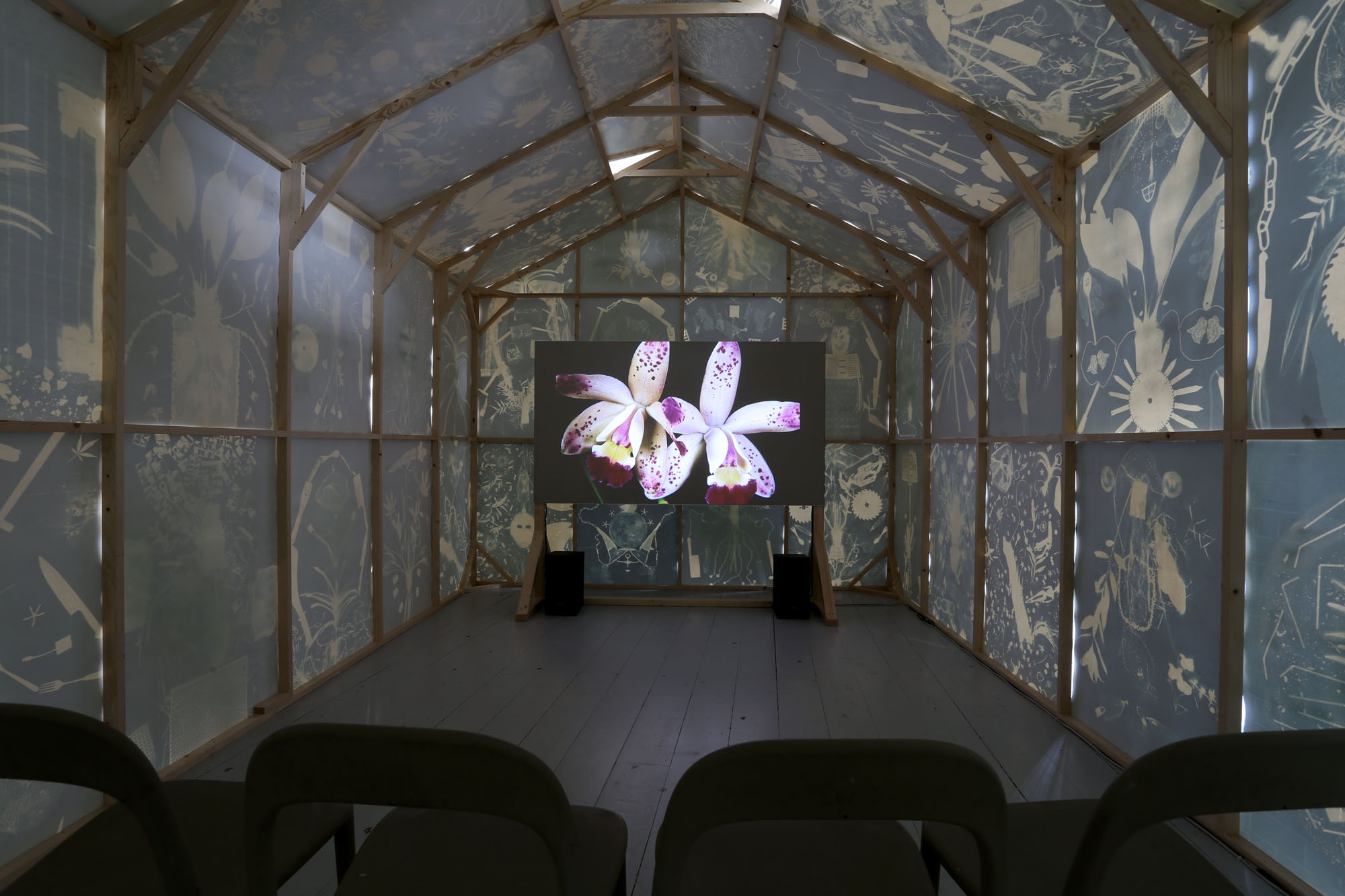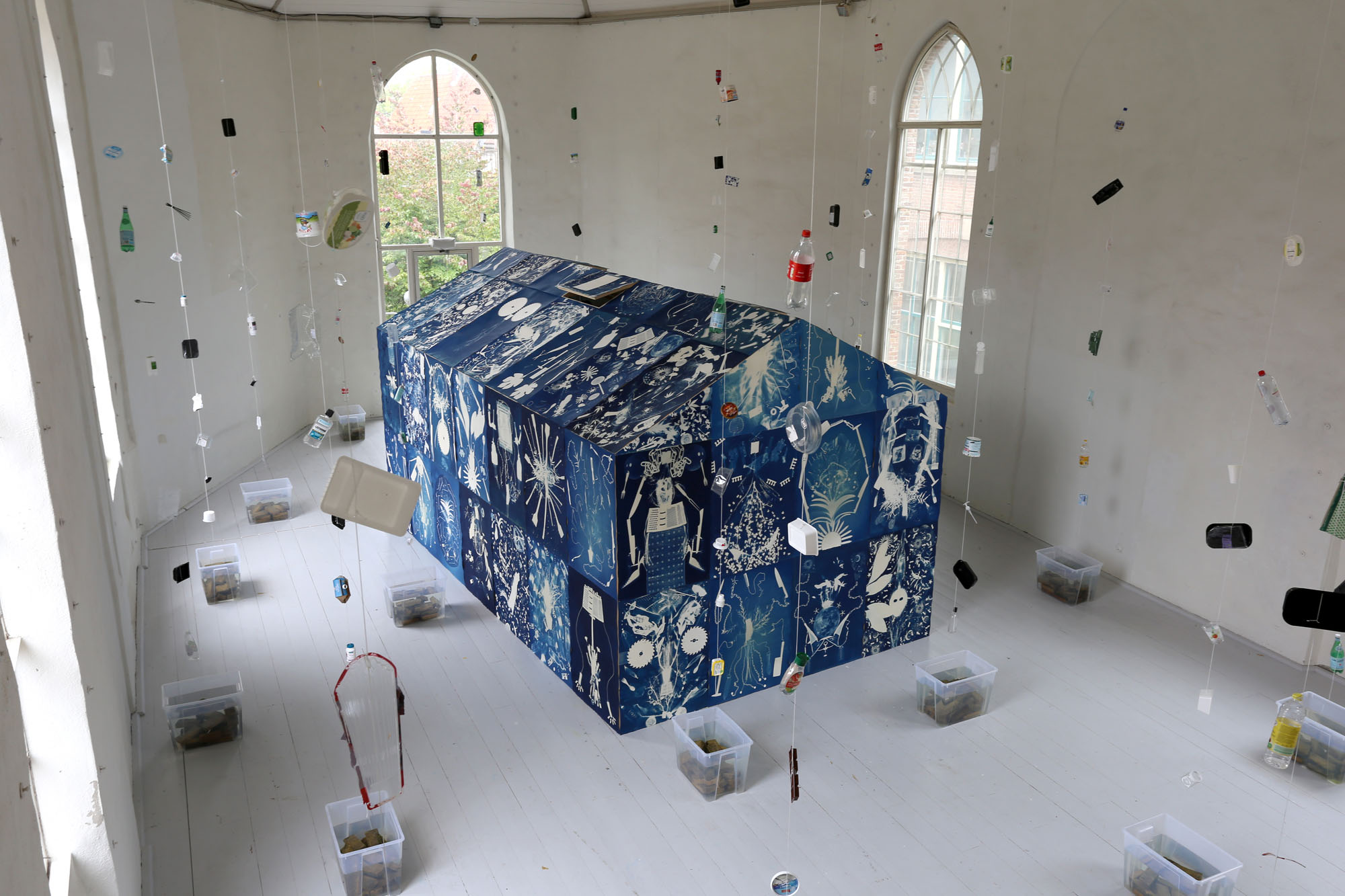Artist: Arvo Leo
Exhibition title: Sun Windows Moon Tendrils
Venue: Hotel Maria Kapel, Hoorn, The Netherlands
Date: June 22 – July 28, 2019
Photography: Arvo Leo and Bart Treuren / all images copyright and courtesy of the artist and Hotel Maria Kapel, Hoorn
Sun Windows Moon Tendrils; a man on a roof, spider webs in the attic, orchids vandalizing a couch, plastic garbage tendrils, floating bricks, a blue house, liquid windows, plant self-portraits, a hole in the floor, wet hands, a gang of bats and fish, free weed, a movie in the basement, two young gardens, squatting plants, hungry bees, an ecology of intermingling images and spaces.
The exhibition Sun Windows Moon Tendrils at Hotel Maria Kapel is Arvo Leo’s first incarnation of his flower trilogy; an entangling of his ongoing research into orchids, cannabis, and tulips. Leo’s works often have a close connection with the space they are being exhibited, with playful and absurd films being made on location that allow space for the audience to participate in.
For this new site-specific indoor and outdoor work, consisting of several sculptures, organic interventions and two films, Leo has used many parts of the building to establish a local ecology between these spaces and their respective images. As a result from this entangling, two new garden spaces have been created at the entrance of the Hotel Maria Kapel that have become occupied by flowering plants over the duration of the exhibition.
In the exhibition space at Hotel Maria Kapel, a former chapel, Leo has built a cinema called Blue House that is inspired by the typical greenhouse design and the immersive paintings of Giotto in the Scrovegni Chapel in Padua, Italy. The skin of the blue house is made from almost a hundred paper cyanotypes; each one depicting a self-portrait made by an orchid. In these selfies the orchids are often posing with other plants, sea creatures, celestial symbols, and human objects and garbage found around the home and studio. Their images make fun of our addiction to consumption and our reliance on tools while revealing that the plants themselves are obviously aware of the idea of images and how they are constructed.
Inside the blue house is Leo’s film The Orchids/Had the Look of Flowers That Are Looked At; a stop-animation movie that shows a group of orchids moving around his studio vandalizing things, making selfies, having a funeral etc. The activities of these plants could be seen as acts of communal play while at the same time as acts of resistance and protest towards the domestication that has been imposed upon them.
For his new site-specific film Two Gardens Leo has used many parts of the building including the rooftop, the facade, the chapel, and the attic. In this film (which screens in the basement cinema) we witness a man on the roof of the building fishing for bricks with a long string adorned with plastic garbage. He lowers this garbage tendril down to the sidewalk and with the help of a group of bats, fish, beets, and seaweed (which Leo uses as organic fertilizer for growing plants) a brick is connected to the string and pulled back up to the roof. This process repeats itself many times until all the bricks are removed, thereby creating openings in the city floor that can be converted into garden spaces.
After a brick has been pulled up to the roof, the man drags it with the garbage tendril through the dusty attic. He eventually lowers the brick down into the chapel and places it inside a water-filled container, which Leo calls ‘liquid windows’, that are based on the measurements of the panes of glass in the chapel windows. After being immersed in water for a few days, these bricks transform into a temporary currency; a currency that viewers of the exhibition can use to trade for dried cannabis flowers that occasionally rise up from a hole in the floor; flowers that Leo grew last year on a roof in Amsterdam.
By removing the bricks out of the liquid windows and carrying the bricks over to the hole in the floor visitors have the opportunity to engage with the sculptures themselves, to become interconnected with the exhibition’s ecosystem, and to help in the process of making more space in the city for squatting plants and their pollinating visitors.
Plant List:
– Echium vulgare ‘Viper’s-bugloss’
– Cerinthe major pupurea
– Erodium variabile ‘Bishop’s Form’
– Dianthus Deltoides ‘Brilliant’
– Polemonium boreale
– Baptisia Dutch Chocolate False Indigo
– Salvia Purple Ginny
– Erigeron karvinskianus
– Leontopodium alpinum ‘Edelweiss’
– Salvia elegans
– Salvia la Siesta
– Anthemis tinctoria
– Hyssopus officinalis
– Ruta graveolens ‘the Wine Glass’
– Phlox subulata “Fabulous Blue Violet”
– Campanula cochleariifolia
– Chaenorhinum Ori. ‘Blue Dream’
– Coreopsis Lanc. ‘Sterntaler’
– Campanula carp. ‘Weisse Clips’
– Geranium cinereum ‘Ballerina’
– Rhodanthemum hosmariense ‘Casablanca’
– Geranium sanguineum
– Potentilla Nep. “Miss Willmott”
– Campanula Rot. ‘Thumbnell Blue’
– Coreopsis Ros. ‘American Dream’
– Clematis armandii ‘Apple Blossom’
– Delphinium ‘Blue Jay’
– Potentilla Gibson’s Scarlet
– Hypsela reniformis
– Bupleurum falcatum
– Catananche caerulea
– Campanula ‘stella’
– Salvia “Royal Bumble”
– Penstemon smallii
– Iberis semp ‘Absolutely Amethyst’
– Acinos alpinus
– Silene acaulis ‘mount snowdon’
– Anthericum liliago
– Polemonium caeruleum albiflorum
– Saponaria sicula intermedia
– Geranium ‘Brookside’
– Salvia nemorosa ‘Blue Bouquetta
– Ceratostigma ‘Forest Blue’
– Platycodon grandiflorous “Hakone Blue”












































